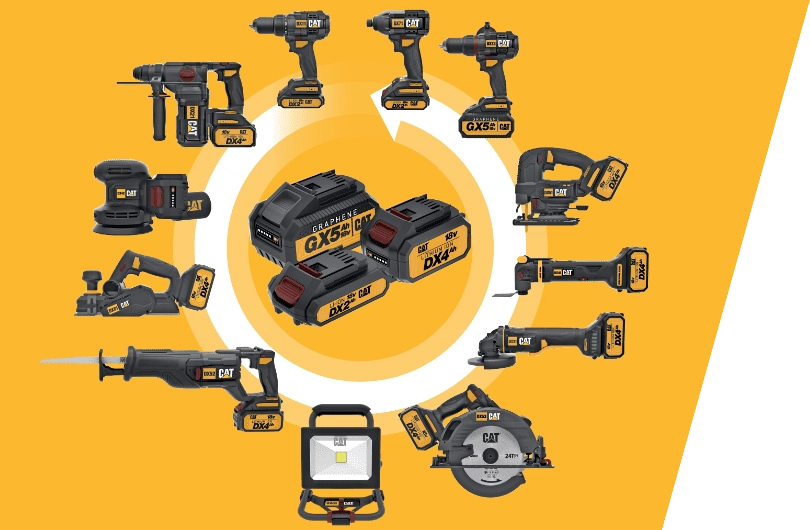Each year tool brands from around the world compete with each other to put out newer and better tools that raise the standards for tool users everywhere. This has led to insanely powerful tools for both pros and everyday homeowners. But where do we go from here? Some say a new battery type is coming and some think graphene batteries are the answer. In fact, brands like CAT have already invested in the technology and have a lineup of tools powered by graphene batteries.
But can graphene really out perform lithium-ion? Today’s #NewToolNews deep dives into graphene battery technology and what it can mean for the future of power tools.
Guide
What is Graphene?

Never heard of graphene? Have you ever seen a graphite rock?
Well, from a scientific standpoint, graphite is a naturally occurring element made from “carbon rich materials” found in rocks. Graphene is just a one atom-thick layer extracted from this same material. Not so wild, right?
But why do people want to put graphene in power tools?
Unlike lithium-ion, graphene is a “quasi-metal”, meaning it shares a lot of characteristics of metal without being one. One of these characteristics is that it is a conductor and it’s a very good one, maybe even the best. This is one of the major reasons people are interested in incorporating it into battery technology, because it could more effectively transfer energy from battery to tool. This transfer is actually where the majority of battery power loss occurs. In theory, graphene batteries should also recharge more quickly for the same reason.
In addition to better energy transfer, graphene batteries should offer better thermal control. This would prevent batteries from overheating, which leads to longer performance and overall longer battery life. This could also result in safer batteries all around.
Advantages of Graphene Batteries
Now that you are aware of what graphene is and what makes it appealing for power tools, here is a roundup of the potential benefits of graphene batteries:
- Longer battery life
- More battery life cycles
- Faster recharge times
- Improve heat control
- Safer, less combustible batteries
- Made from renewable resources
Disadvantages of Graphene Batteries
Graphene batteries have a lot of exciting potential, but there still are some disadvantages:
- Expensive to produce and manufacture
- Battery technology is still in development
- Lack of certainty about mass production
Despite all of the potential for graphene batteries, it will probably be a few years before we see significant developments. Creating graphene is an expensive and relatively new process. Scientists successfully extracted graphene for the first time in only 2004. This process is barely 20 years old. Unless the process of creation becomes cheaper, graphene batteries will struggle to become a mainstream option for consumers. Because even if graphene batteries are great, the price point might just be too high.
Will Graphene Replace Lithium-Ion?
Graphene very well still could replace Lithium-Ion in power tools. Yes, this is a new process. However, it’s also a fast evolving process. CAT has already applied the technology to some of its own power tools. More companies are also experimenting with graphene batteries, such as Samsung and a few auto manufacturers.
At this point I’m not confident enough to say that graphene batteries will become the number one power source for everyday consumers. However, I see potential for high-quality graphene power tools being adopted by skilled trade professionals and the industrial construction industry.
Graphene Power Tools on the Market

Graphene power tool technology is still in the early phase of its development so it’s not commonly used. However, I mentioned CAT Power Tools has developed graphene batteries. These CAT GX5 18V 5.0Ah Graphene batteries are high-capacity batteries.
When compared to Lithium-Ion batteries CAT claims these batteries…
- Have four times longer life
- Charge three times quicker
- Run twice as long before hitting thermal cutoff
CAT has released some new 18V power tools to pair with the GX5 batteries. Currently these 18V tools are the only tools compatible with the graphene battery. It will be interesting to see if CAT develops a graphene battery for the its higher volt tools and outdoor power equipment.
Right now, CAT is the only power tool manufacturer with a graphene battery. Now that the technology is out there I wonder if we’ll start to see more brands produce a similar battery.
Wrap-up
Graphene clearly has a lot of potential in the power tool world. I’m excited to see CAT putting the technology to use, but will we see more of it? I think the biggest struggle with a new technology is just getting it out there. Once the product is finished it can be expanded and refined. CAT put this battery out last year. Will we see a new battery from Milwaukee? DeWALT? Metabo HPT?
Is this the beginning of an avalanche of new power tool technology?
COMMENT with your thoughts on this graphene battery technology. Do you think the industry will change? Do you think there is something better coming? Let us know what you think.


